|
John Bagnall and Sons
The Bagnall family came from
Broseley, where John Bagnall was a mining engineer. He
was baptised at the Parish Church on 4th November, 1730.
The church is now known as All Saints’ Church, but when
John Bagnall lived there it was an earlier building,
known as St. Leonard’s.
He married Margaret Dixon in St.
Leonard’s on 2nd December, 1753, and they had seven
children: William, Elizabeth, John, Edward, Mary,
Daniel, and Margery. In the 1770s the family moved to
Darlaston where they had a house and land in Pinfold
Street. John had a number of coal mines on his land, and
mentioned in his will that he extracted coal in his
garden. He died in 1800 and was buried in the graveyard
at St. Lawrence’s Church on 19th March. His wife
Margaret was buried there on 12th February, 1815.
Their descendants founded and ran
coal mines and iron works in Wednesbury and West
Bromwich, and created a business that became one of the
area’s largest producers of coal and iron in the first
half of the 19th century.
Around 1780 John Bagnall and his
sons acquired Golds Hill Iron Works in West Bromwich,
alongside the canal, near to the Wednesbury boundary.
They also mined some of the surrounding land under the
terms of a lease obtained from the land owner, Lord
Dartmouth, which entitled him to one fifth of the annual
profit each year. The mines were extremely productive.
In 1859 3,527 tons of coal were extracted from Lewisham
Pit which made an annual profit of £973. The following
year a total of 4,236.5 tons of coal was removed, and
the profit increased to £1,058.
|
|
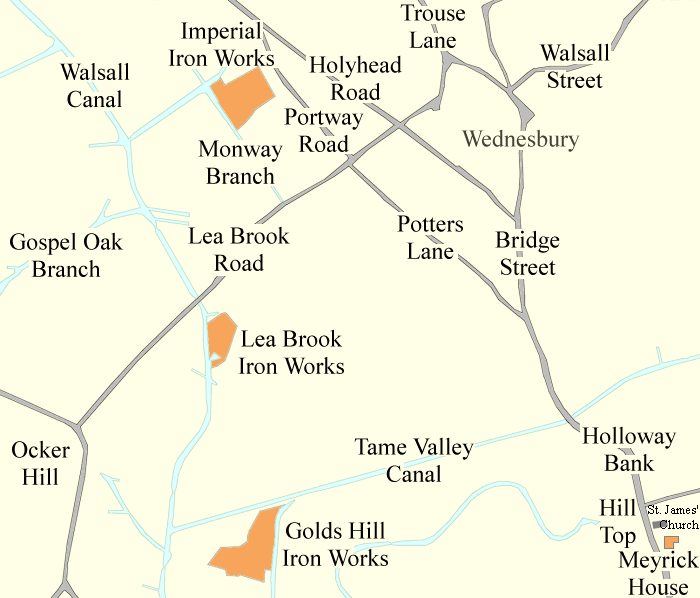
The location of Bagnall's
ironworks in Wednesbury and West Bromwich. |
|
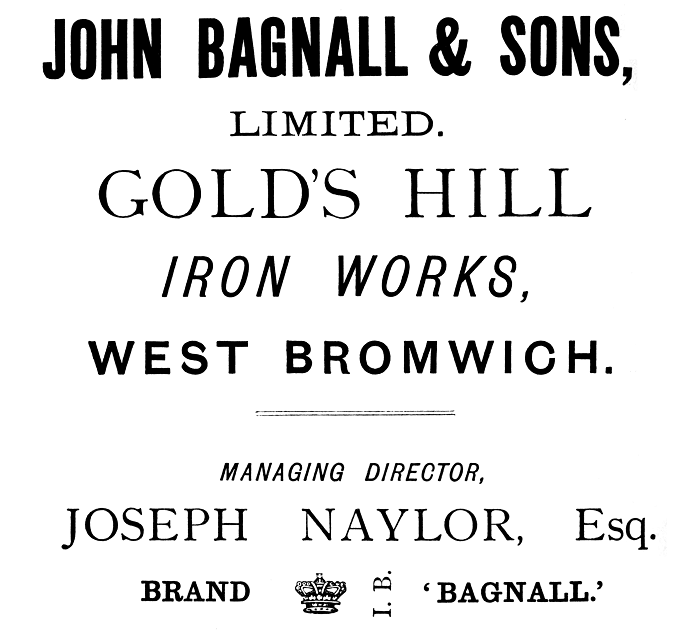
An advert from Griffiths' Guide to
the Iron Trade of Great Britain, published in 1873. |
|
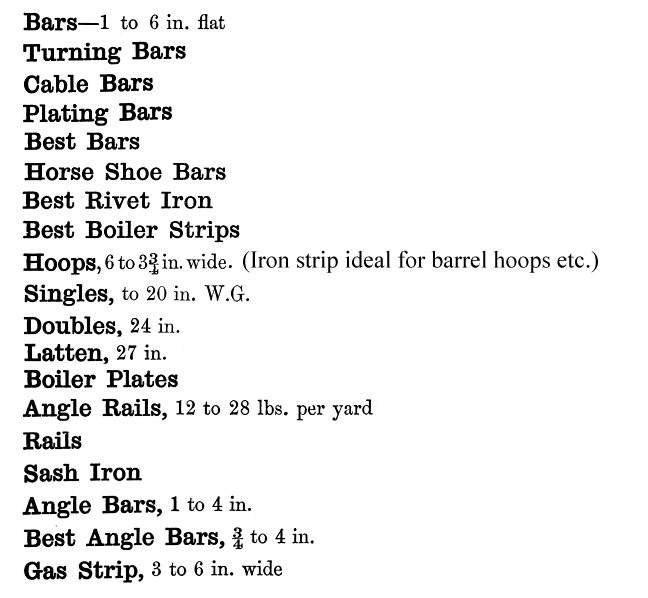
A list of products from 1873. |
|
John Bagnall and Sons was
established in 1800 by John Bagnall junior. He was
joined in the business by his five sons: John, William,
Thomas, Samuel, and James. The firm soon acquired Lea
Brook Iron Works, at Wednesbury. John admitted his five
sons into co-partnership with him on 24th June, 1828. He
died in the following year on 23rd of November. John's
brother Edward married Mary Wilkes from Tipton, but died
at the early age of 44 in 1805. His daughter, Martha,
married Edward Charles Thorneycroft, the twin brother of
Wolverhampton’s first mayor George Benjamin Thorneycroft
who ran Shrubbery Iron Works.
The company acquired the
Capponfield Iron Works at Bilston, where there were
three blast furnaces producing first class grey forge
iron. In 1872 only two of them were in blast.
John Bagnell junior died on 4th
February, 1840 and was succeeded as head of the firm by
his brother William who became a member of
the Institution of Civil Engineers in 1848. At the end of 1844 they acquired the
Imperial Iron Works from John Russell & Company, and by
1848 Bagnalls produced around 250 tons of iron each
week, using the I B Crown brand name. In 1851 the
company won medals at the Great Exhibition for the I B
Crown iron, and soon afterwards installed a simple
single cylinder beam engine
made in Wednesbury by James Davies to power their
rolling mill. The engine continued in use until the
1950s.
In 1857 Thomas Bagnall left the
firm and retired from the iron trade. In September of
that year his sons John Nock, Charles, and Thomas Junior
also left the firm. They then became involved in coal
and ironstone mining at the Ward Colliery, Bloxwich.
John Nock Bagnall also wrote the first history of
Wednesbury which was published in 1854. |
|

The notice that appeared in
the London Gazette on 15th September, 1857. |
|
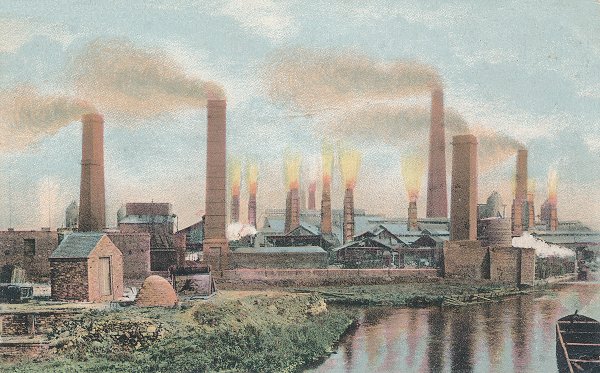
Lea Brook Iron Works photographed
from the bridge over the canal. |
|
James and William retained control of John Bagnall &
Sons, with Richard Bagnall as partner in some of the
coal mines. Sadly William Bagnall died suddenly
on 12th August, 1863 at his family home, Hamstead Hall
in Handsworth. He was 66 years old.
The last surviving member of the
Bagnall family to be involved in the company was James
Bagnall who died at his home, Meyrick House, Hill Top,
West Bromwich, on 12th of January, 1872. He became a
member of the Institution of Civil Engineers on the 16th
of February, 1841, and became an active County
Magistrate. He was appointed as a Justice of the Peace
in October, 1845 and later became a Deputy Lieutenant
for the County of Stafford. His funeral service was held
at St. James’ Church, Hill Top, which was next door to
his house. A large number of people including the
company's employees and some of his poorer neighbours
attended the funeral.
The
Bagnall family gained a reputation for being considerate
employers. In March 1853 they began to run
evening classes for their employees in a purpose-built
school that opened four nights a week. Classes began at
7p.m. By the end of the year there were 227 students
ranging in age from 10 to 20. They were taught general
knowledge and given text books. In 1855 a school for
boys, girls, and infants opened at the factory. It was
intended for children of the employees, but also open to
outsiders. School fees were between two pence and six
pence per week. That year there were 226 children at the
school, which was known as Golds Hill School. The school
board purchased the site and buildings in 1878, and
after improvements, reopened the school as a board
school for boys, girls, and infants. The school survived
until 1950. |
|
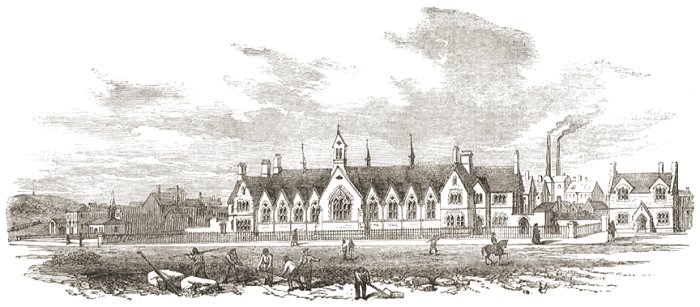
Golds Hill School from The
Illustrated London News, 3rd February, 1855. |
|

Imperial Iron Works. |
|
The street that runs through Golds
Hill was named after the Bagnall family and is still
called Bagnall Street. The family name is still well
known today because William Gordon Bagnall established
the Castle Engine Works at Stafford, where Bagnall
railway locomotives were made. |
|
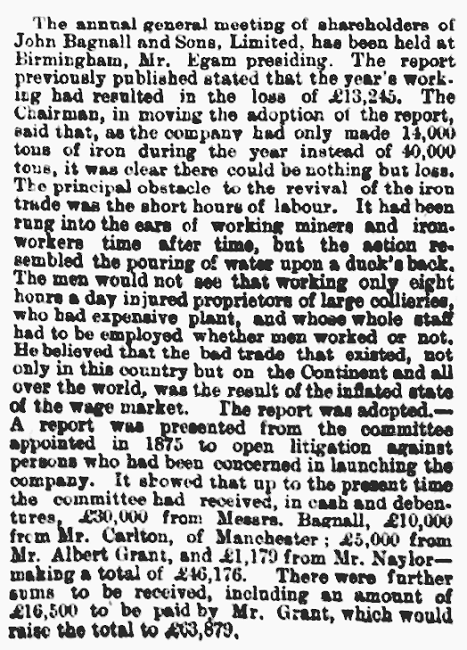
From The Western Mail, 11th March,
1878. |
In 1872 there were three blast
furnaces at the Golds Hill site, two of which were in
blast, producing first class grey forge iron. There were
also 75 puddling furnaces and 8 mills and forges.
As a result of James Bagnall's death, John Bagnall & Sons Limited was
incorporated in 1873. The Directors were A. E. Wenham
(Chairman), M. J. Whitehouse, G. W. Butler (Managing
Directors), T. P. Harris and J. C. Forrest. At the time
they had around 400 employees.
By 1878 things were going badly wrong. Sales of iron
had fallen to an all-time low, and the coal mines were
largely worked-out. The business was reconstructed. The
blast furnaces were now uneconomical to run and so the
Golds Hill factory closed, and was offered for sale in
1881.
Many of the company’s mines closed, or were sold, and
Imperial Ironworks was sold to the Patent Shaft and
Axletree Company in the 1890s. Bagnalls then decided to
concentrate solely on the Lea Brook Iron Works. |
|

An advert from 1897. |
|

An advert from 1907. |
| The Lea Brook site managed to survive. It became a
subsidiary of N. Hingley & Sons of Netherton Iron Works
in about 1918. Wrought iron continued to be produced
there until the mid 1930s along with some crude iron
which was produced until 1958.
In 1960 Lea Brook works were re-rolling steel made
outside the district into strip for the car industry.
Around 250 people worked there at that time.
The factory closed in the 1980s recession, and was
demolished in 1992. |
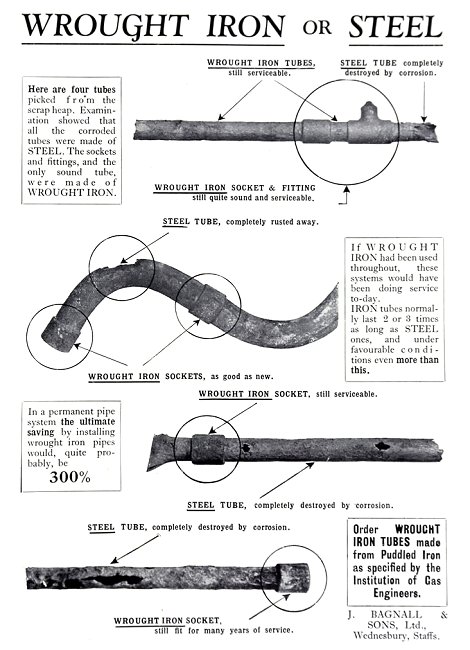
An advert from 1931. |
|
 |
Return to the
previous page |
|